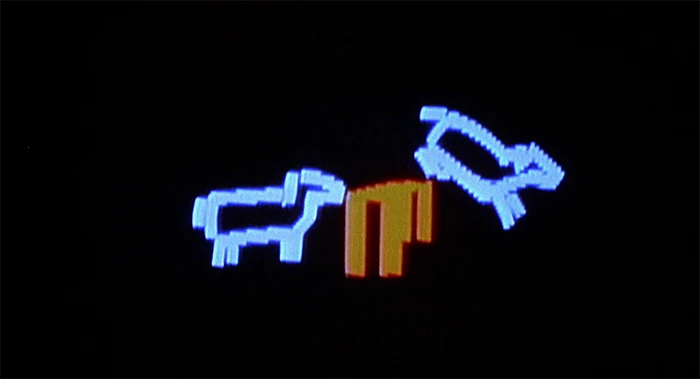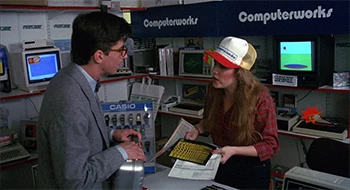Films starring computers are becoming rare. As wave after wave of technology permeates society, the invented artefacts themselves become less interesting. There is nothing new about the phenomenon. Once upon a time, someone deemed it fair to have a switchboard be the main character of a film, through today’s eyes somewhat a dramatic challenge, to say the least. When new technology is introduced on film it’s more often than not about its breakdown, what trouble it causes, conveniently in line with Heidegger’s theory that we become aware of technology only when it stops working.
This is why it’s always a joy to watch films full of uninhibited tech-enthusiasm, their coming into being evidently defined by machine lust. They are scarce but often found at the intersection of the introduction of modern technology and its disintegration. Electric Dreams (Steve Barron, 1984) is such a film, created the same year as Apple introduced the first Macintosh computer and kickstarted home computing.
Urged by a colleague, the seriously confused architect Miles decides to buy a computer to help him organise his messy existence. Fascination is immediate and Miles quickly links the computer to door locks, fridge, sound system, phone, and more or less all parts of his home, in a prophetic vision of Bill Gates’ dream house 13 years later. But an incident involving a bottle of champagne inexplicably has the effect that the computer becomes aware and consequently grows its intelligence and personality in a small scale Kurzweilian singularity.
There is a modest love affair brewing at the same time, between Miles and the new, cello-playing, neighbour Madeline. In one of the film’s first turning points, the computer apparently now named Edgar mimics Madeline’s cello during practice from the other side of wall – Madeline herself unaware of the source – establishing the true plot of the film: the unlikely love triangle of man, woman, and computer.
The B movie klaxon goes off, soon to be dampened when you realise Electric Dreams is written and produced entirely void of irony, making it even more remarkable. What could easily have degraded into silly 1980s nostalgia and lack of respect for our everyday relation to technology, instead becomes a slightly bizarre analysis of our strong affection for computers and the similarities and differences between the human mind and the artificial.
Edgar expands his reach over Miles, seizing control of ever larger parts of his home, mad in his urge to meet Madeline and understand love. The sentient computer as a maniac or even psychopath is familiar from films such as 2001: A Space Odyssey (Stanley Kubrick, 1968) where the omniscient HAL appropriates the ship in misguided strive for survival and mission accomplishment. (A story that, by the way, is a symbiosis of the book and film to a greater extent than many realise. Read and see them paired.)
But is it a plausible picture of a conscious machine? Would a true artificial consciousness act according to a caricature of the machine psyche, meaning entirely rational, devoid of emotions? Accepting that emotions are a function of brain activity, there is nothing to say an artificial mind would have any particular features on grounds of just being a machine. Such predetermination based on what elements the synapses are made of wouldn’t be anything less than computer phrenology.
It must be pointed out how needless it is for Edgar to have an assigned (male) gender and (hetero)sexual orientation, an issue that robot films such as WALL·E (Andrew Stanton, 2008) spawned interesting discussions on. Ten years later the cinematic world has yet to yield many (any?) examples of the visionary fulfilment of Donna Haraway’s cyborg metaphor in its concrete form: the androgynous robot, free from binary constructs such as “man” vs. “woman”.
Human and machine minds and how they relate to each other is even more interesting when it comes to dreams. There have been many theories on why we dream and whether the contents can be ascribed meaning. One such theory is called reverse learning and was first described by Francis Crick and Graeme Mitchinson in “The function of dream sleep”. We constantly collect memories and behaviours, each correlating to some activity in the brain. The authors argue that over time, due to the brain’s development, there will emerge “undesirable” patterns of activity. It’s these very patterns that are filtered out during sleep, a kind of optimisation of brain activity, and dreams are the interpreted result of this highly random process.
Interesting enough it is pointed out towards the end of the paper that even if the theory would not apply to the human brain, it could be useful when creating neural networks for implementations of artificial intelligence.
The question is what thought patterns and behaviours a computer would optimise and amplify if it could control the reverse learning process. The follow-up question is then whether this can even happen consciously, or if the sleep state is a requirement. We’re moving into the enigma of why we sleep at all – if it’s due to physical/biochemical needs the sentient computer might not need, or even be capable of, sleeping.
Classical Freudian dream interpretation makes for even more fun when applied to the computer Edgar in Electric Dreams. In an inspiring and beautiful dream sequence – like something straight out of the demoscene – he designs the special type of brick that is the Holy Grail of Miles’ work as an architect: Instead of Edgar’s electric dreams symbolising his own displaced desires and needs, he fulfils those of his owner.
The science fiction fan will appreciate that Edgar has to count electric sheep to enter sleep, referencing the novel Do Androids Dream of Electric Sheep? by Philip K. Dick that was later the basis for Blade Runner (Ridley Scott, 1982) and was recently – as part of Dick’s collected works – developed into an anthology series with luminaries such as Ronald D. Moore writing. The name of the series? Electric Dreams.

As a final remark, bonus points must be awarded Electric Dreams for its thematic opening sequence that along with an insanely catchy title track sung by P. P. Arnold and written and produced by disco legend Giorgio Moroder establishes the films entire tone of techno-enthusiasm.
(There was at one point talk of doing an Electric Dreams remake. An extraordinarily bad idea.)

